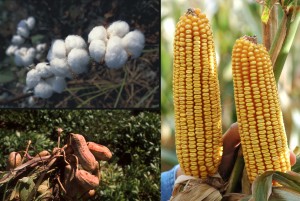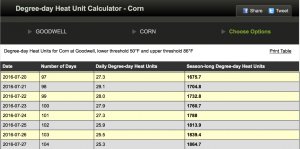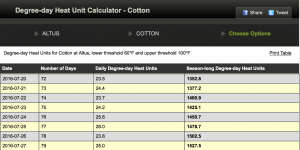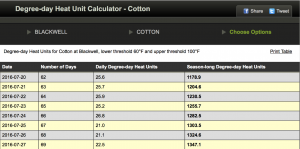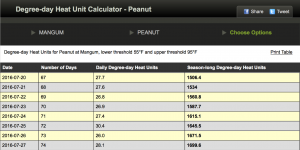As July comes to an end in Oklahoma, farmers’ thoughts are jumping ahead to harvest. Farmers that planted corn, cotton and peanuts are thinking about the heat units those crops need to mature. They want their efforts to end in good yields and good quality. To check on crop maturity they can turn to the Oklahoma Mesonet Degree-day Heat Unit Calculator.
Degree-day Heat Units is one of those tools that is really valuable if you don’t think too much about the name. It is a way to monitor daily and accumulated crop heat units. The accumulation of crop heat units compared to the heat units needed for a crop variety to reach maturity let’s farmers monitor crop progress and when a crop might be ready to harvest. What can throw folks is that degree-day refers to the way the units are calculated. Units are neither in degrees or days.
The term degree-day refers to taking the high for the day and the low for the day and dividing that by 2. For each crop we also have a lower and upper temperature threshold that enters into the calculation. This is done to capture the temperature range that actually contributes to crop maturity. When temperatures are too cold or too hot, plants go into a holding state that does not add to their maturity.
Degree-day heat units needed for maturity varies widely for field corn varieties, from 2,100 to 3,200 corn heat units. How is the corn crop doing in 2016?
Let’s assume we planted a 2,800 degree-day maturity field corn in Pauls Valley on April 1st. As of July 27th, Pauls Valley had accumulated 2,542 corn degree-day heat units. That only leaves 258 corn heat units to go before maturity. This crop could be ready to harvest the week of August 8th to 12th this year.
Up in Goodwell, let’s also assume we planted a 2,800 degree-day maturity field corn. As of July 27th, Goodwell has accumulated 1,865 corn heat units. If the daily average of heat units through August 31st is 25 per day, a Goodwell corn crop will accumulate 875 corn heat units by August 31st. That will leave 60 corn heat units needed in September to get the crop to maturity. That means our Goodwell corn crop could be ready for harvest in the first full week in September.
Turning to cotton, the degree-day heat units for maturity ranges from 2,200 to 2,600 cotton heat units.
Our first cotton example is from Altus with a planting date of May 10th. As of July 27th, this crop had accumulated 1,528 cotton heat units. If we planted a longer season variety that needs 2,500 cotton heat units to reach maturity, the cotton crop needs another 972 heat units in 2016. If we average 24 cotton heat units per day through August 31st, that will leave 132 cotton heat units needed in September. That should give us all the heat we need to reach full maturity in the second or third week in September.
Jumping north to Blackwell, our cotton crop example was planted on May 20th. Since Blackwell traditionally accumulates less cotton heat units, the cotton variety planted was a 2,300 cotton heat units variety. Having accumulated 1,347 cotton heat units as of July 27th, we need 953 cotton heat units to finish out the 2016 growing season. If we average 22 heat units per day in August, we’ll accumulate 770 cotton heat units by August 31st. That will leave 183 cotton heat units needed in September. Our heat situation for cotton in Blackwell this year looks good.
Our last crop example is Peanuts at Magnum. Peanuts need between 2,400 and 2,700 peanut heat units. If a 2,600 peanut heat unit variety was planted on May 15, it would have collected 1,700 peanut heat units as of July 27th. That leaves 900 peanut heat units to reach maturity. If the daily average through August 31st is 27 heat units per day, our crop will collect another 945 peanut heat units. That’s more than the 900 needed, so our peanut crop has plenty of heat to finish the season.
2016 has been a great year for summer crops. There has been plenty of warm days and for most areas in Oklahoma timely rain events. It’s been a hot year for livestock and humans, but temperatures have been good for crop plants. The degree-day heat units collected each day has kept summer crops growing and ticking down the days to harvest.
To learn more about the Mesonet Degree-day Heat Unit Calculator, read the heat unit description document.
